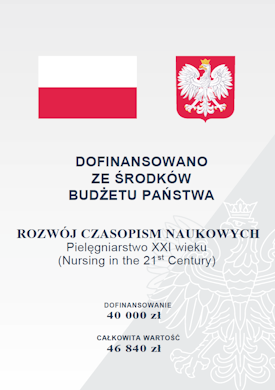The assessment of acceptance of the use of e-health systems in chronic care among nurses
Keywords:
telemedicine, e-health, chronic disease, nursesAbstract
THE ASSESSMENT OF ACCEPTANCE OF THE USE OF E-HEALTH SYSTEMS IN CHRONIC CARE AMONG NURSES
Aim. The study was aimed at assessment of the use of e-health systems in care for patients suffering from chronic disorders.
Material and methods. The questionnaire addressing the issues of the use of information technology tools, opinions about determinants of e-health development and acceptance for its use in chronic care. In this paper, the analysis of results of the survey related to the aspect of the support of chronic patients was presented. The survey was performed in the group of 215 nurses participating in extension courses in the period from November 2011 to January 2012 in Krakow.
Results. The questionnaires were filled by 175 nurses (response rate 81.4%). For the analysis, 153 of them were selected due to quality criteria. A group of respondents (67.4%) believe that health care system in Poland does not assure adequate care to patients with chronic diseases, and 65.5% of them agree that the use of telemonitoring system may enhance chronic care. In opinion of respondents, among e-health applications designed for patients, the priority should be given to systems enabling making appointments with physician in the Internet, online access to laboratory test results and tools for monitoring of disease course.
Conclusions. Nurses reveal high acceptance for the use of e-health applications in chronic care, apart from the system replacing traditional direct contacts between patients and physicians. Age, professional experience and use of the Internet did not influence the opinions about the use of e-health systems for support of chronic patients.
References
1. Wu SY, Green A. Project of Chronic Illness Prevalence and Cost Inflation. Santa Monica, Calif. RAND, October 2000.
2. Kennedy A, Rogers A, Bower P. Support for self-care for patients with chronic disease. BMJ. 2007; 335: 968-970.
3. Pare G, Jaana M, Sicotte C. Systematic Review of Home Telemonitoring for Chronic Disease: The Evidence Base. J Am Med Inform Assoc. 2007; 14: 269-277.
4. Eysenbach What is e-health? J Med Internet Res. 2001; 3(2): 20.
5. Centrum Systemów Informacyjnych w Ochronie Zdrowia. Kierunki informatyzacji „e Zdrowie Polska” na lata 2011-2015. Warszawa 2009. [Data cytowania 21.01.2013] www.mz.gov.pl/wwwfiles/ma_struktura/docs/kierunki_e_zdrowie_09022011.pdf.
6. Demiris G, Afrin LB, Speedie S et al. Patient-centered Applications: Use of Information Technology to Promote Disease Management and Wellness. A White Paper by the AMIA Knowledge in Motion Working Group. J Am Med Inform Assoc. 2008; 15: 8-13.
7. Garde S, Harrison D, Hovenga E. Skill needs for nurses in their role as health informatics professionals: a survey in the context of global health informatics education. Int J Med Inform. 2005; 74: 899-907.
8. Smedley A. The Importance of Informatics Competencies in Nursing: An Australian Perspective. CIN: Computers, Informatics, Nursing. 2005; 23(2): 106–110.
9. Duplaga M. The opinions about e health among nurses employed in hospitals located in urban area in Poland. CIN: Computer Informatics Nursing (w druku).
10. Takahashi Y, Ohura T, Ishizaki T et al. Internet Use for Health-Related Information via Personal Computers and Cell Phones in Japan: A Cross-Sectional Population-Based Survey. J Med Internet Res. 2011;13(4): e110.
11. Duplaga M. Acceptance of Internet-Based Health Care Services Among Households in Poland: Secondary Analysis of a Population-Based Survey. J Med Internet Res. 2012; 14(6): e164.
12. van de Poll-Franse LV, van Eenbergen MC. Internet use by cancer survivors: current use and future wishes. Support Care Cancer. 2008; 16: 1189-1195.
13. van Uden-Kraan CF, Drossaert CHC, Taal E, et al. Health-related Internet use by patients with somatic diseases: frequency of use and characteristics of users. Inform Health Soc Care. 2009; 34(1): 18–29
14. Dillon TW, Blankenship R, Crews T. Nursing attitudes and images of electronic patient record systems. CIN: Computers, Informatics, Nursing 2005; 23(3); 139–145.
15. Im E, Chee W. Nurses’ acceptance of the decision support computer program for cancer pain management. CIN: Computers, Informatics, Nursing. 2006; 24(2): 95–104.
16. Eley R, Soar J, Buikstra E et al. Attitudes of Australian Nurses to Information Technology in the Workplace: A National Study. CIN: Computer Informatics Nursing. 2009; 27(2): 114-121.
17. Renahy E, Parizot I, Chauvin P. Health information seeking on the Internet: a double divide? Results from a representative survey in the Paris metropolitan area, France, 2005–2006. BMC Public Health. 2008; 8: 69.
18. Weber S. A qualitative analysis of how advanced practice nurses use clinical decision support systems. Journal of the American Academy of Nurse Practitioners. 2007;19: 652–667.
19. Chan MF. A cluster analysis to investigating nurses’ knowledge, attitudes, and skills regarding the clinical management system. CIN: Computers, Informatics, Nursing. 2007; 25(1): 45–54.
20. Richards H, King G, Reid M et al. Remote working: survey of attitudes to e-Health of doctor and nurses in rural general practices in the United Kingdom. Fam Pract. 2005; 22: 2-7.
Downloads
Published
Issue
Section
License
Copyright (c) 2013 Mariusz Duplaga (Autor)

This work is licensed under a Creative Commons Attribution 4.0 International License.




